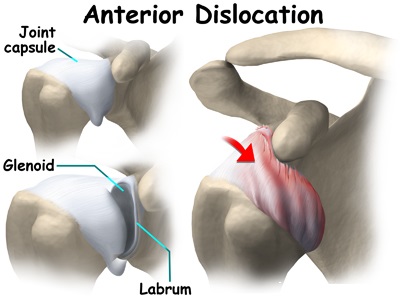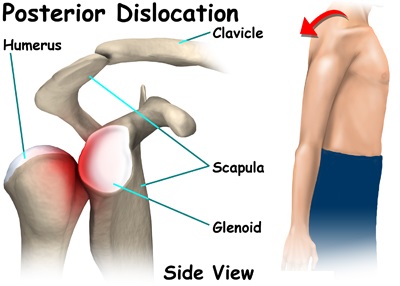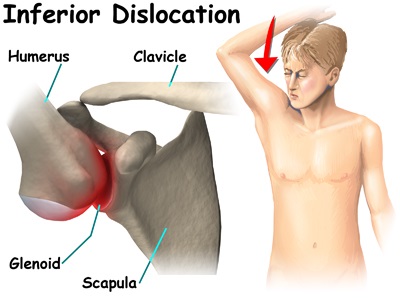Shoulder dislocation is separation that occurs between the glenoid socket of the spatula and humerus. Dislocation in the shoulder is one of the most common joint dislocations due to its variety of movements and the frequency of application. But, what are the main shoulder dislocation types?
Three Types of Shoulder Dislocation
The determination of the type of dislocation is based on the location of the humeral head from the shoulder socket (glenoid) when the diagnosis is made. There are three main types of shoulder dislocation.
1. Anterior Shoulder Dislocation

This anterior dislocation accounts for 95 percent of shoulder dislocations. It has four sub-types named according to how the dislocated head is positioned: subclavicular, sub-glenoid, sub-coracoid and the rare intrathoracic.
In an anterior shoulder dislocation, the humeral head separates from the glenohumeral joint. This ruptures or detaches the anterior capsule from the humeral head or its attachment at the edge of glenoid fossa.
Many anterior shoulder dislocations are a result of extension, abduction or rotating the shoulder externally. This happens in activities such as spiking in volleyball and overhead ball throws. It can also result from falling on an outstretched arm.
2. Posterior Shoulder Dislocation

In posterior dislocation, the upper part of the humerus is displaced toward the back of the body. Severe internal rotation as well as adduction cause most posterior shoulder dislocations. These result from imbalances of strength in the rotator cuff muscles. This rare type of dislocation may also result from a direct blow or falling on an outstretched arm.
3. Inferior Shoulder Dislocation

Of all shoulder dislocation types, inferior shoulder dislocations account for less than one percent. It results from hyper abduction which forces the head of the humerus against the acromion. This pushes the arm behind the head or upwards so that it appears to be held up.
Most cases of inferior shoulder dislocations also involve fractures or soft tissue injuries. They usually involve neurovascular complications arising from vascular, tendon, ligament and neurological injuries.
What Are the Symptoms of Should Dislocation?
Shoulder dislocation symptoms include:
- Extreme shoulder pain
- Limited shoulder movement
- Abrasion or bruising on the shoulder
- Distortion of the shoulder
- Squared appearance of the side in an anterior dislocation
- Flat frontal shoulder in posterior dislocation
- Hard knob near the shoulder
How Is Shoulder Dislocation Diagnosed?
Doctors rely on physical examination and history to diagnose shoulder dislocation types and associated fractures or injuries.
- Physical inspection indicates a dislocation when the round contour of the shoulder is lost and becomes flat or squared. Strength, sensation and range of motion are also tested. Loss of sensation or other changes may indicate nerve damage. The doctor will also check the pulse to identify possible vascular complications.
- Clinical tests are conducted to identify soft tissue rupture or structural damage. A positive apprehension test diagnoses an unstable shoulder which is likely to dislocate again after the current case. The test involves abducting (pulling) the arm outwardly, and rotating it to a point where it is about to dislocate and the patient is extremely anxious. The positive test is discontinued at this point.
- An X-ray is also used to confirm the dislocation and any fractures. The imaging will be conducted from different perspectives to give a better view of the dislocation and injuries. Magnetic resonance imaging may also be used to show the extent of any lesions.
- In the event that surgery is required, the surgeon will order for a diagnostic arthroscopic exam which involves a fiber optic video camera inserted in the shoulder joint so that the surgeon can see the state of the dislocation.
How to Treat Shoulder Dislocation
1. Get First Aid
Irrespective of the shoulder dislocation types, once it occurs, seek emergency medical attention at a hospital or clinic. Take care to keep the shoulder steady and if possible, immobilize in a sling to protect from further injury.
Some of the pain and swelling can be dissipated by applying icepacks for up to 15 minutes at a time and repeating once an hour as required. Do not, however, put ice directly on the shoulder.
2. Reduction
Reduction refers to the procedure of returning the dislocated humerus bone into the socket. This should be done as soon as possible by a qualified medical professional to prevent further damage. Whenever possible, an X-ray should be taken to confirm there are no fractures. Where this service cannot be accessed immediately, a post-reduction X-ray should be done as soon as possible. If it is difficult to perform the reduction or it is too painful for the patient, the procedure should be performed under anesthesia. Surgical reduction is the most effective and permanent procedure for active young adults of 30 years old and below.
3. Immobilization
The shoulder is normally immobilized using a sling with the arm crossing the front of the body. Immobilization should be sustained for 5 to 7 days, and longer in case of soft tissue injuries or a fracture. Your doctor may prescribe ibuprofen or other NSAIDs to help with the pain and inflammation.
4. Surgery
Sometimes shoulder dislocation requires surgery. This usually happens when a shoulder dislocates repeatedly or there is a fracture or serious damage to the labrum, blood vessels, muscles, tendons or nerves. The operation is carried out as soon as possible. Surgery for recurring dislocations is aimed at stabilizing the shoulder joint.
Several surgical procedures are available and are used depending on the patient’s lifestyle. Some surgery procedures may lead to reduction of external shoulder movement. These are unsuitable for sports people in racket and throwing sports.
5. Rehabilitation Exercises
Once pain and swelling subside, your doctor prescribes appropriate rehabilitation exercises to help in your recovery and restoration of muscle strength and shoulder movements. Rehabilitation can also help to prevent recurrence of the dislocation. Rehabilitation begins with muscle toning exercises and progresses through to weight training.
Here’s a video for you to watch:
